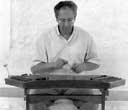The Santouri in Lesbos
 |
Lesbos, a well-forested island, is the largest in the Eastern Aegean. Olive oil is its most important agricultural product. According to S. Anagnostou, it was exported, during the late 18th c., to Constantinople, Russia and all over Europe. This rich trade lasted till the Asia Minor disaster in 1922. The contact with these countries, notwithstanding cultural exchange, brought the new form of santouri to Lesbos.
The presence of the santouri in Lesbos is mentioned for the first time, in the book by the French mechanic De Launay "Close to the Greeks in Turkey" (Paris 1897). He describes balls on Sundays in Aghia Paraskevi, where spirits rise when "three musicians appear one after the other, while playing. The first one has a kind of mandolin called lute (Laouto), the second uses a little hammer to strike the strings of his instrument, and the third carries a violin."
The santouri, the favored instrument of the Lesbians, combined with the violin, enriched and embellished the wind ensemble. The santouri players were numerous. Our limited research allows us to list their names, although our catalogue is far from complete.
Apostolos Valavanis, Dimitris Ververis , Persefoni Ververi, Giannis Ververis, Meghaklis Ververis, Giorgos Ganosis, Giorgos Gianakos, Kostas Zafeiriou, Vassillis Katsambis, Michalis Karteris, Giorgos Kavarnos, Posidonas Karavas-Divaris, Manolis Kallaitzis, Dimitris Kranidiotis, Vasilis Moskovis, Pantelis Pantelelis, Gianis Pantelelis, Giorgos Sarantidis, Panagiotis Stamboulis, Dimitris Sterianos, Michalis Tsimnadis, Giorgos Tyropolis, Giannis Christou, Stratis Psyras.
However, distinguished virtuosos, like Giorgos Hantzelis and Nikos Kalaitzis, must be dealt with in more detail:
Giorgos Hantzelis, nicknamed 'Hahina' or 'Veva' , (1895-1973) was famous all over the island. He was born in Akrasi. On finishing high school, he went to Vrisa, where he was taught the santouri. In order to completely master the instrument he continued in Moschonisia. There he studied theory of music and harmony, thus becoming a professional musician. As did most at this time, he emigrated to America. There he also learnt the cymbalom. He played with Rumanian, Hungarian and Greek ensembles. In 1929 he was repatriated. Besides participating in his local village ensemble he teamed up with the best musicians all over the island. He was a fanatical santouri player and had a very particular style. Both Nikos Kalaitzis (Bindaghialas) and Giannis Susamlis (The Criminal, 'Kakourgos' in Greek) learnt from him and copied his style. They always talked about him with admiration, considering him a great master.
Giannis Susamlis or "The Criminal" (1928-1996) was born in Agiassos. He was taught music by his father who was a clarino virtuoso. Very talented, he stood out for his dexterity and speed. He used his instrument to its full extent, except the counter bass strings, which he removed. His agility and precision in moving up and down the instrument was "pleasant to the ear" and provided a rich musical texture. He was very imaginative in the art of variation, either simplifying the theme or creatively embellishing it. He used no muffling on the sticks as he preferred a hard sound. In order to obtain uniformity in his sound, he removed the coated counter bass strings and replaced them with simple ones, made of copper.
Nikos Kalaitzis or "Bindaghialas" was born in Mesotopos in 1925. He descends from a family of musicians. He plays santouri, violin, bouzouki, and used to play the trombone. A santouri virtuoso, he uses 'soft' sticks and places leather between the strings and the bridges in order to obtain a smooth sound, similar to the cymbalom. He was influenced by Hatzellis, but also owed a lot to the Rumanian masters of the cymbal.